
Image: IDG / Matthew Smith
When looking for a laptop for school, you not only want one that helps you get through your classwork and homework but also something you can have fun with in your free time. It needs to be powerful enough for your late-night gaming sessions, yet portable enough to be a comfortable everyday carry.
It might be a bit overwhelming shopping for a new laptop if you don’t know where to start, but don’t worry. We went ahead and carefully curated a list of the best gaming laptops specifically for students. We’ve taken everything from display quality to portability to budget into consideration. Read on to learn more about our picks.
[Need something strictly for schoolwork? Check out our picks for the best laptops for college students]
Updated 07/11/2023: To include the latest Lenovo Legion 5 Pro (2023) as our choice for best overall. Read our summary below for more info on this best new pick.
Lenovo Legion 5 Pro (2023) – Best overall
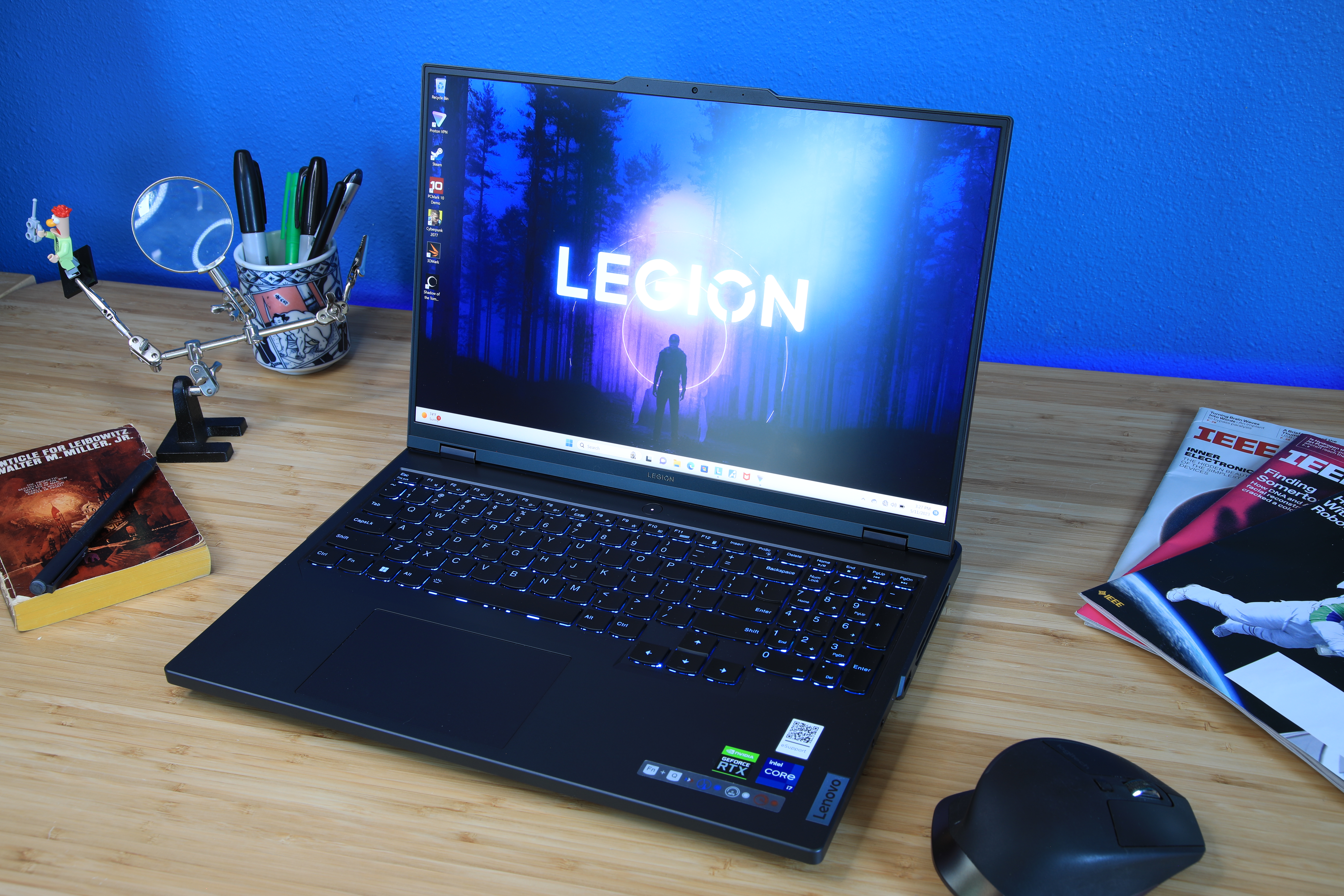
Pros
Handsome design
Excellent keyboard
Lots of connectivity
Strong CPU and GPU performance
Cons
Heavy and bulky
Mediocre display
Short battery life
The Lenovo Legion 5 Pro ticks off a lot of boxes. It offers fantastic gaming performance, a wide range of connectivity options, a rugged design, and so much more. Plus, the pricing is competitive, meaning even college students on a budget don’t need to go on a instant-ramen only diet to afford it. This machine is more than capable and the best bang for your buck as a student looking to game.
Lenovo packed their latest Legion 5 Pro model with an Intel Core i7-13700H CPU, an Nvidia GeForce RTX 4060 GPU, 16GB of RAM, and 512GB of SSD storage. They didn’t skimp on the laptop’s screen either as the non-touch IPS display has a resolution of 2560×1600 and a maximum refresh rate of 165Hz. The display is also bright, but it’s not as colorful as others we’ve seen. Overall, strong performance and competitive pricing make this laptop an excellent choice for gamers.
Read our full
Lenovo Legion 5 Pro review
Asus VivoBook Pro 15 OLED Ultra Slim Laptop – Best budget option
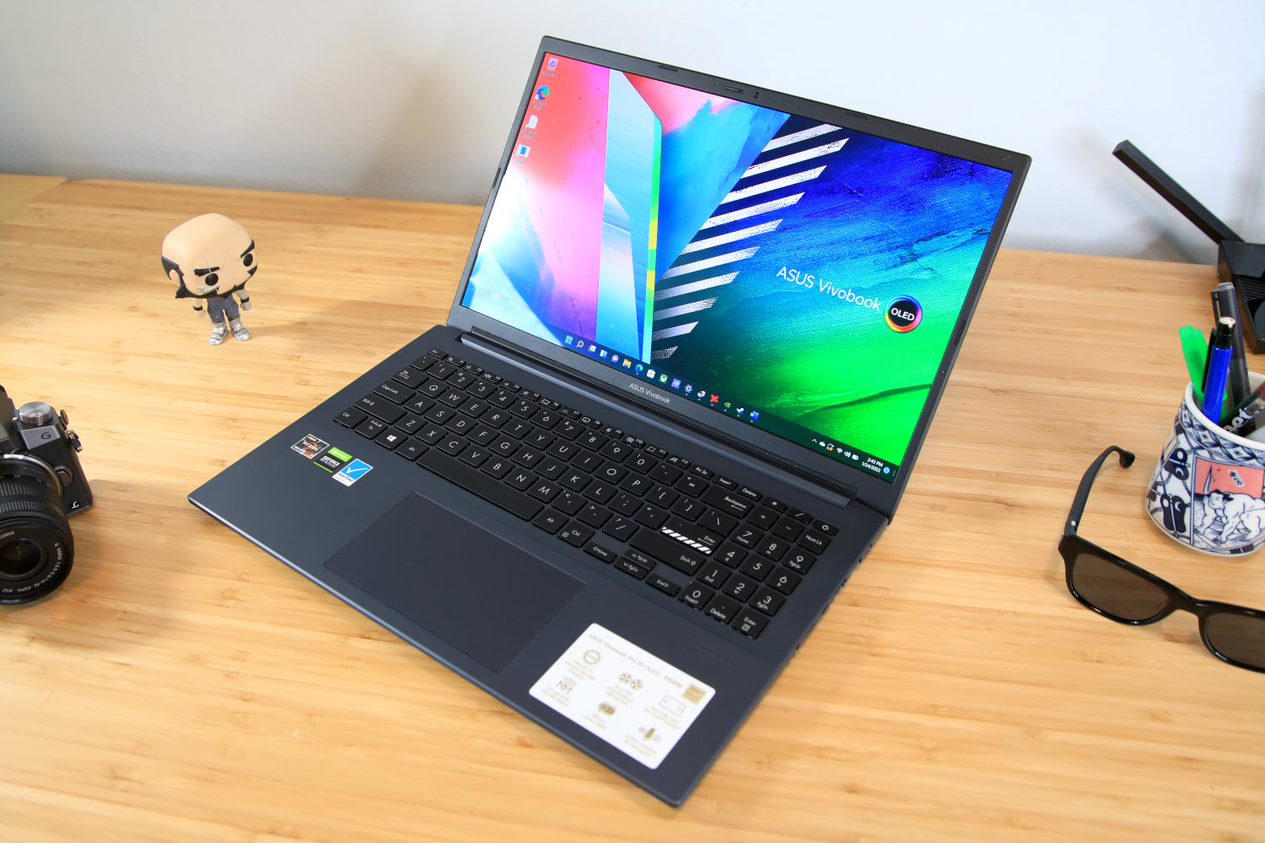
Pros
Good productivity performance
Superb display
Rugged design
Great battery life
Cons
Boring aesthetics
Unimpressive 720p webcam
Unreliable fingerprint scanner
Poor port selection
If you’re looking for strong gaming performance at an affordable price, the Asus VivoBook Pro 15 OLED is a fantastic choice. According to our tester, this laptop can easily handle “gaming, streaming, and day-to-day productivity.” It has an AMD Ryzen 7 5800H CPU, an Nvidia GeForce RTX 3050 GPU, 16GB of RAM, and 512GB of NVMe PCIe SSD storage. You may need to drop down to medium or high graphics when playing newer AAA titles. That said, this machine should be able to run older games just fine. The OLED panel is also superb and battery life is great. In fact, it lasted over 11 hours on a single charge during our battery-life benchmark. That’s impressive for a gaming laptop. There are a few minor nitpicks to be aware of, though.
The fingerprint scanner is downright finicky and the overall aesthetic is uninspiring. The port selection isn’t too diverse, either. If you can live with those caveats, the VivoBook Pro 15 OLED is an absolute joy to use and well worth considering. If you’re interested in more budget gaming laptop recommendations, be sure to check out our picks for the best gaming laptops under $1,500 and the best gaming laptops under $1,000.
Read our full
ASUS VivoBook Pro 15 OLED Ultra Slim Laptop review
Acer Nitro 5 – Best budget option runner-up

Pros
Strong CPU/GPU pairing for the price
Roomy 1TB SSD with room to add second drive
Decent battery life
Quiet operation
Cons
Plastic chassis is bulky and hefty
Dim display
So-so keyboard and tiny touchpad
Terrible webcam
Another option for the budget-conscious buyer is the Acer Nitro 5. This 17.3-inch laptop provides ample performance and plenty of screen real estate for a very reasonable price. It includes a Ryzen 7 processor, RTX 3060 GPU, 16GB of RAM, and a 1TB PCIe M.2 SSD. Those are pretty good specs for a laptop that frequently goes on sale for under $1,000.
The main reason it didn’t take the top spot over the Asus Vivobook Pro 15 was due to the differences in displays. The Vivobook Pro 15 comes with a stunning OLED display while the Acer Nitro 5 only has a 1080p IPS panel. The Nitro 5 is also a bit more expensive, but it does come with a bit more performance for that money. Overall, the two are very close, but which you buy will likely come down to what is most important to you—slightly more gaming performance, or a better display.
Read our full
Acer Nitro 5 AN517 review
Lenovo Slim 7 Pro X – Best ultraportable for gaming
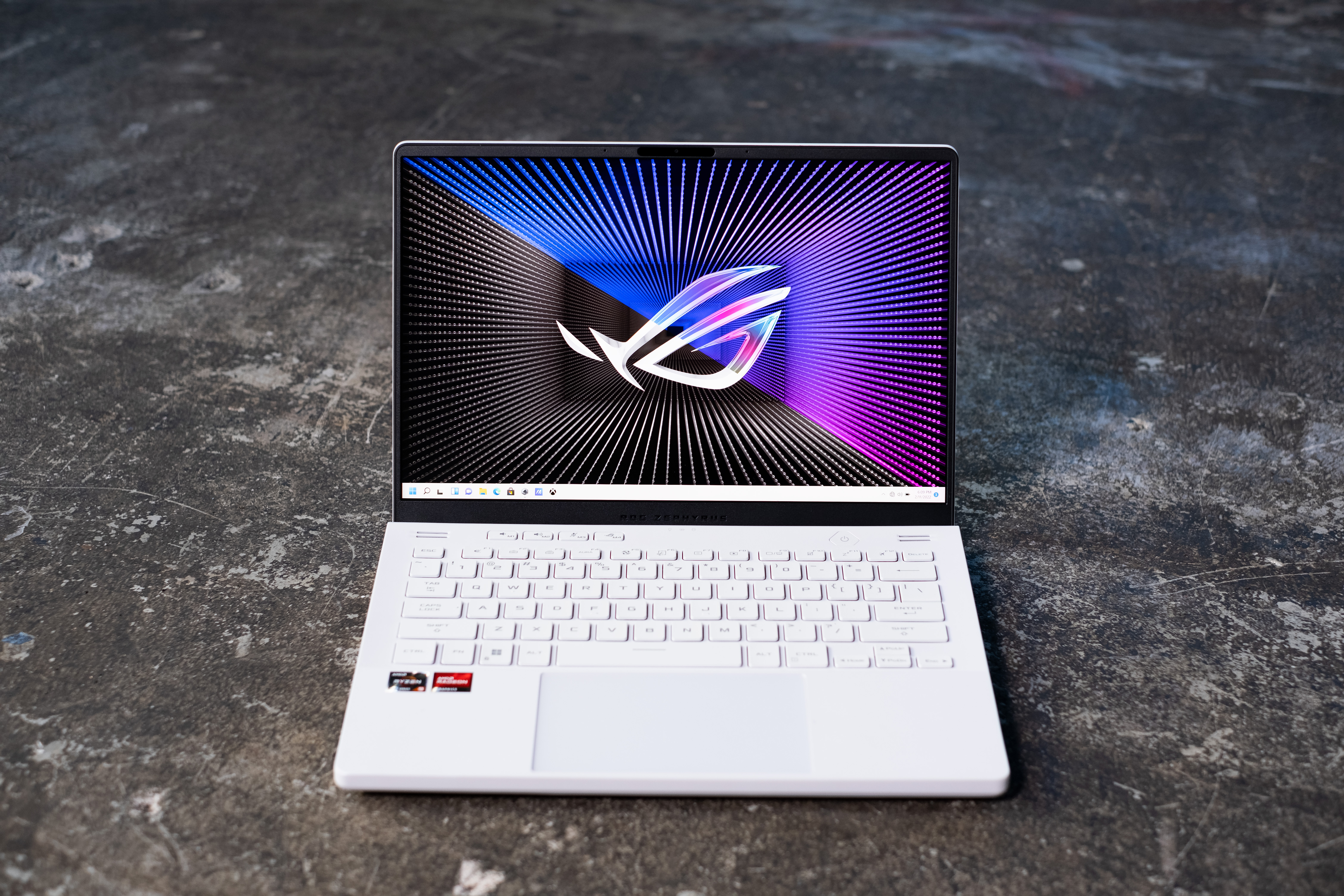
Pros
Attractive, robust design
Thin profile, low weight
Enjoyable keyboard and touchpad
Excellent processor performance
Cons
No Thunderbolt 4, Ethernet, or dedicated video-out
Display is sharp, but falls behind OLED alternatives
Battery life is slightly behind the pack
The Lenovo Slim 7 Pro X combines the rare combination for gaming laptops of being both ultra-lightweight and powerful. Weighing in at just over three pounds, it lives up to the name of ultraportable. In such a tiny package they somehow manage to fit an AMD Ryzen 6900HS CPU and an Nvidia GeForce RTX 3050 GPU. This means that you can expect strong gaming performance even while on the go.
There honestly aren’t many knocks against it. While the display is sharp, it’s not OLED and the battery life is lacking a little bit. But these are minor inconveniences and don’t really take away from the overall appeal of this ultraportable. One thing to note however is that the RTX 3050 GPU is fine for most games, but it won’t be able to handle ray tracing, so if playing at the ultra settings is important then you may want to consider a laptop with a more robust graphics card. However, if you’re looking for a portable gaming laptop that promises solid performance, the Lenovo Slim 7 Pro X is a great option.
Read our full
Lenovo Slim 7 Pro X review
HP Victus 16 (16-d0097nr) – Best keyboard

Pros
Very good value
Surprisingly comfortable keyboard
Large 16-inch 1080p screen with a high 144Hz refresh rate
Cons
Budget RTX GPU
Audio doesn’t feel quite right
Display hinge is a bit flimsy
The HP Victus 16 has a really comfortable keyboard, which is great for schoolwork because of longer typing sessions. According to our tester, he was “happy to use the keyboard on a long-term basis.” HP put a number pad in there as well, which is perfect for gamers. But how does it perform? Well, let’s get into the guts then.
This laptop should be able to run most older games on medium to high graphics, as well as everyday tasks like writing papers, browsing the web, and so on. It features an Intel Core i7-11800H CPU, an Nvidia GeForce RTX 3060 GPU, 16GB of RAM, and 512GB of PCIe NVMe SSD storage. The 16.1-inch display has a resolution of 1920×1080 and a refresh rate of 144Hz. The display hinge is a little flimsy though, so you’ll want to be mindful when handling it.
We didn’t have many knocks against this laptop, but the design is anything but a head-turner, that’s for sure. If you can live with the ho-hum design, the Victus 16 is a solid choice, especially if you’re on a strict budget.
Read our full
HP Victus 16 (16-d0097nr) review
Alienware x15 R2 – Best high-end option
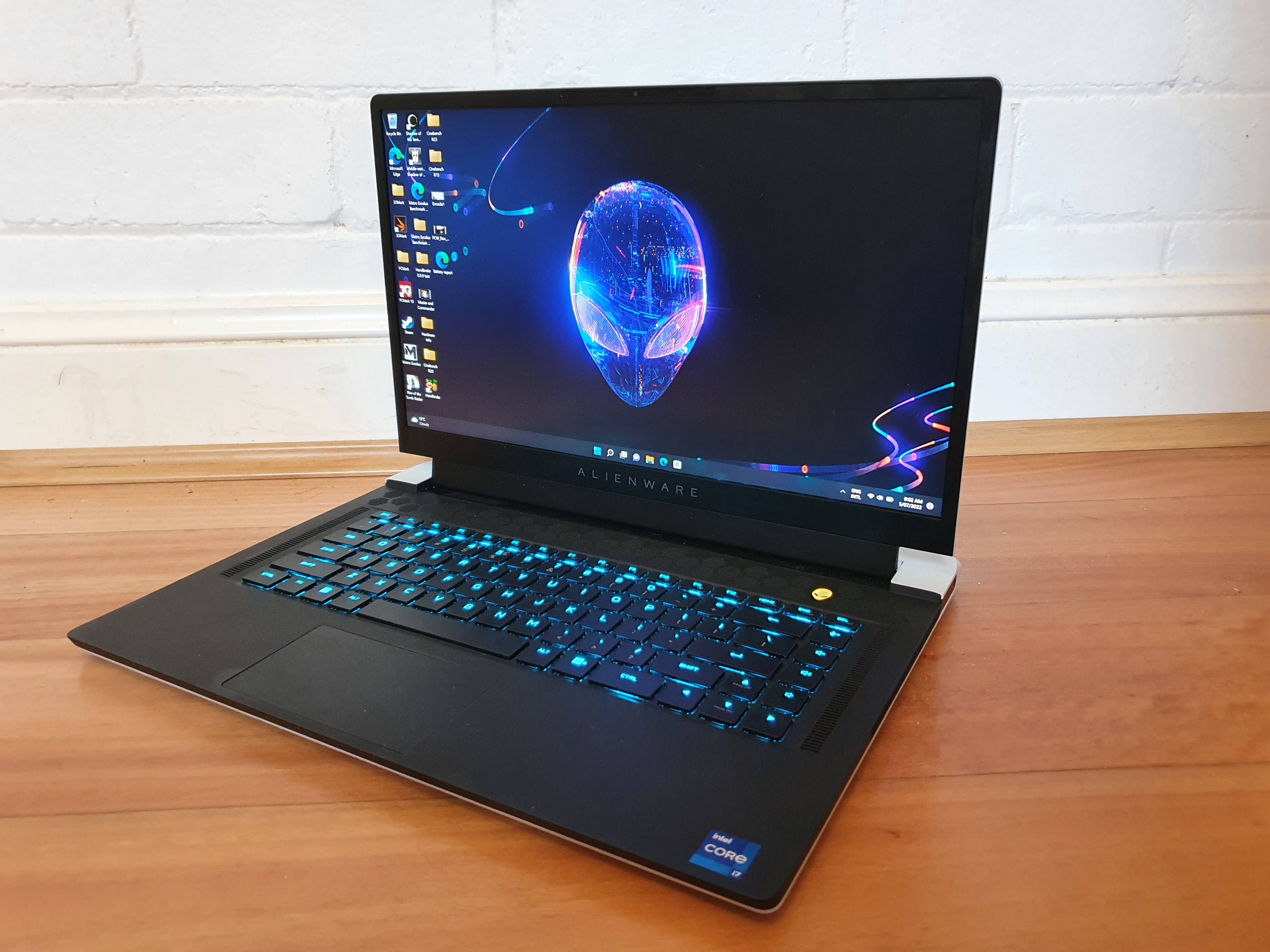
Pros
Ample power for gaming performance
Smooth and gorgeous QHD display
Stunning otherworldly design with RGB lighting
Cons
Rear-orientated ports can be hard-to-reach
Middling battery life unplugged
RAM comes soldered onto the motherboard
If you want the cream of the crop, the Alienware x15 R2 is the one to pick. It’s rocking an Intel Core i7-12700H CPU, an Nvidia GeForce RTX 3080 Ti GPU, 32GB of RAM, and 1TB of PCIe NVMe SSD storage. The 15.6-inch display has a resolution of 2560×1440 and a maximum refresh rate of 240Hz. Wow. Just wow. It has some quirks, though. The rear ports are difficult to reach and the RAM is soldered on. That said, the features really dominate any drawbacks.
If you’re in a position to shell out the cash, the Alienware x15 R2 will surely deliver an out-of-this-world experience.
Read our full
Alienware x15 R2 review
MSI Sword 15 A12UE – Unique style
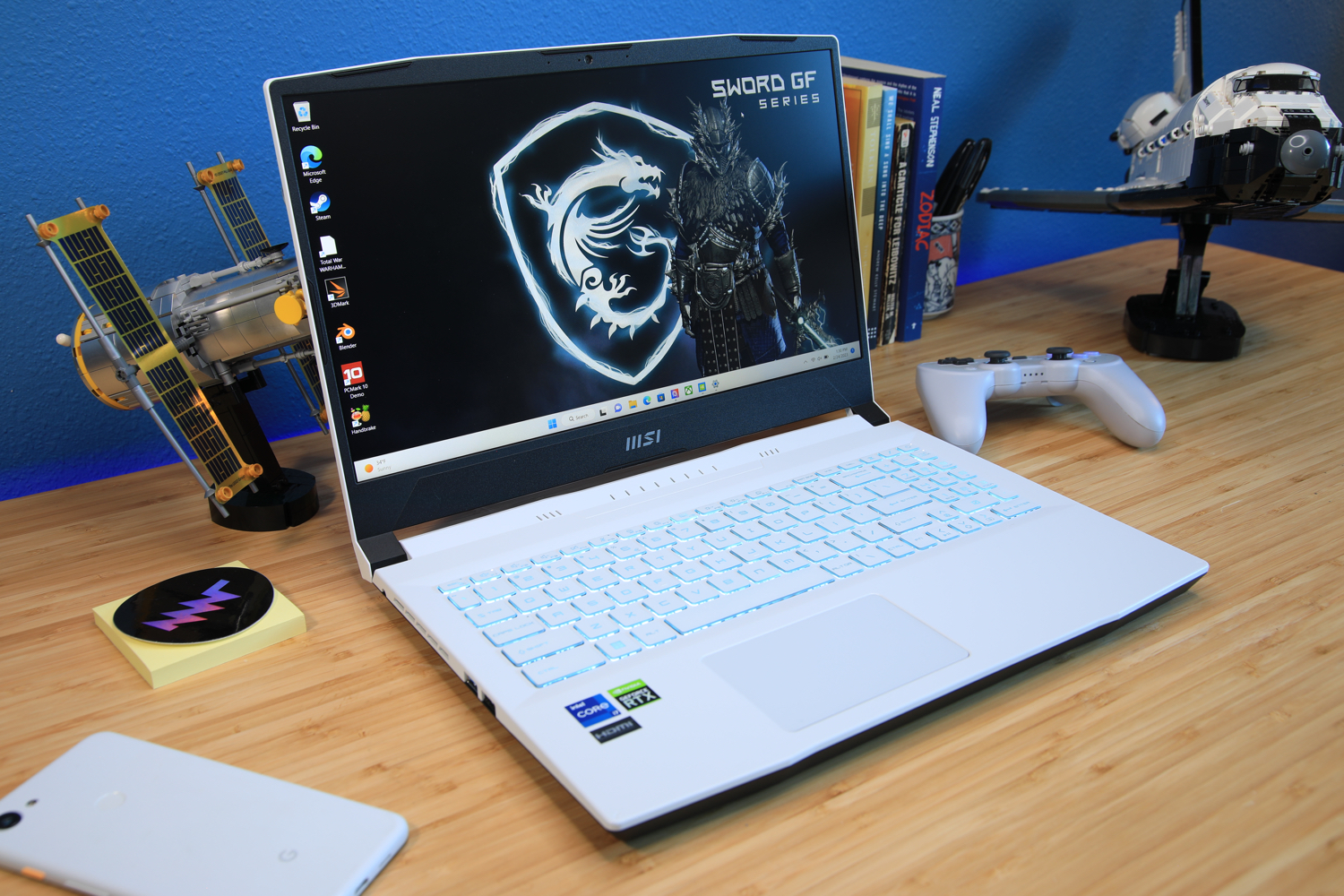
Pros
Attractive, simple design
Lighter than most budget gaming laptops
RTX 3060 can handle most modern games
Competitive pricing
Cons
Mediocre keyboard and small touchpad
Dim display with narrow color gamut
CPU and GPU performance slightly behind competitors
Webcam and connectivity don’t impress
If aesthetics are more your style, then the MSI Sword 15 will undoubtedly impress. While it’s a more-than-capable-enough laptop in its own right, the truly unique design makes the Sword 15 stand out from the pack. Many gaming laptops are bulky, heavy bricks in which aesthetic design seems to be an afterthought. Not so with the Sword 15. It sports a sleek, futuristic look with white and black accents and a cool blue keyboard backlight. And at just 4.96 pounds, it’s also lighter weight than many gaming laptop competitors. It’s a great-looking, well designed budget gaming laptop that will not only look and perform well in class, but also during those after-study gaming sessions.
Read our full
MSI Sword 15 A12UE review
How we tested
The PCWorld team puts every Windows laptop through a series of intense benchmarks that test GPU and CPU performance, battery life, and so on. The idea is to push the laptop to its limits and then compare it against others we’ve tested. Below, you’ll find a breakdown of each test and the reasons why we run them.
Windows laptops
PCMark 10: The PCMark 10 benchmark is how we determine how well the laptop handles general use tasks like web browsing, word processing, spreadsheets, streaming, and so on.
HandBrake: HandBrake is more intensive than PCMark 10. It measures how long a laptop’s CPU takes to encode a beefy 30GB file.
Cinebench: Cinebench is a brief stress test of the CPU cores. It renders a 2D scene over a short period of time.
3DMark: 3DMark checks if 3D performance remains consistent over time by running graphic-intensive clips. This is how we test a gaming laptop’s GPU.
Video rundown test: To gauge battery life, we loop a 4K video using Windows 10’s Movies & TV app until the laptop dies.
FAQ
1.
How much graphics power will I need?
The GPU is important because it’s the component that determines how smoothly your machine handles games. Fortunately, you don’t need the best graphics card to get reliable graphics performance, which is good news if you’re on a strict budget. If you’re looking to save some cash, go for the GTX 1650. It’s an entry-level GPU that’s powerful enough for 1080p gaming on mid-to-high graphics. If you need more oomph and higher frame rates, we’d suggest shooting for a GTX 1660 Ti or higher, or a more current RTX 30-series GPU.
2.
What about processing power?
For Intel processors, aim for a 12th-gen Intel Core i5 or i7. For AMD, go with a Ryzen 4000 or 5000. A processor with four cores is good, but six cores or more is better. More cores helps your machine divvy up the workload.
3.
Are memory and storage options important?
Absolutely! 8GB of RAM is the bare minimum I’d recommend, but if you can afford it, go for 16GB instead. This will help overall browser performance, which is important when you’re doing schoolwork. Memory is typically upgradeable, so you can always swap it out and add more later on.
Storage directly impacts how many games you can install on your computer. You should get at least 512GB of SSD storage plus a hard drive, as newer titles tend to eat up a ton of space. SSDs load games faster because the data is stored on chips rather than a spinning disk. Plus, SSDs are quieter and more power efficient. You’ll also need the space to store homework and so on.
4.
Should I invest in a top-quality display?
Don’t go for anything below 1080p. If the picture isn’t sharp enough or is too dim, you can always pick up an external monitor to plug into. For those who suffer from tension headaches due to eye strain (hi!), 4K is the way to go. That said, 4K displays are expensive because they have higher refresh rates and faster response times.
5.
How long should my laptop last on a single charge?
Generally speaking, most gaming laptops have bad battery life. That’s because they’re power-hungry machines. It’s a lot of work running an AAA title on ultra graphics, you know? Depending on your use, most gaming laptops will last anywhere from four to six hours on a single charge. However, if you limit your use to schoolwork only, you may be able to squeeze out another hour or two.
Author: Ashley Biancuzzo, Associate Editor

Ashley is a professional writer and editor with a strong background in tech and pop culture. She has written for high traffic websites such as Polygon, Kotaku, StarWars.com, and Nerdist. In her off time, she enjoys playing video games, reading science fiction novels, and hanging out with her rescue greyhound.
>>> Read full article>>>
Copyright for syndicated content belongs to the linked Source : PCWorld – https://www.pcworld.com/article/820520/best-gaming-laptops-for-students.html


























![Forest ecology cannot be reduced to arithmetic, says M.I. Varghese [Interview] – Mongabay-India](https://earth-news.info/wp-content/uploads/2025/12/328946-forest-ecology-cannot-be-reduced-to-arithmetic-says-mi-varghese-interview-mongabay-india-120x86.jpg)




